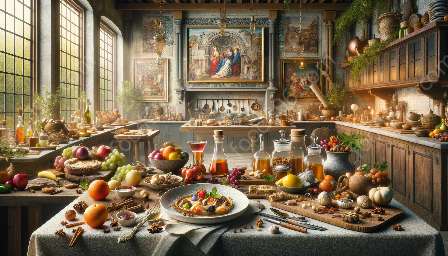The Renaissance period was a time of profound change in Europe, with significant impacts on the culinary landscape. This period, which spanned from the 14th to the 17th century, saw a convergence of various influences that shaped the cuisine of the time. In this topic cluster, we will explore the cultural, social, and geographical factors that influenced Renaissance cuisine, examining the historical context and its implications for culinary history.
Cultural Influences
One of the key influences on Renaissance cuisine was the cultural exchange that occurred during this period. The revival of classical learning and the rediscovery of ancient texts led to a resurgence of interest in the culinary traditions of antiquity. Italian humanists, such as Bartolomeo Sacchi (known as Platina), wrote influential cookery books that drew on both classical and contemporary culinary practices. As a result, the culinary arts were infused with new ideas and techniques, creating a fusion of classical and contemporary cooking styles.
Furthermore, the patronage of the wealthy elite fueled a culture of conspicuous consumption, leading to the development of elaborate banquet traditions and the refinement of courtly cuisine. The Italian courts, in particular, became renowned for their sumptuous feasts and opulent displays of gastronomic prowess, influencing culinary practices across Europe.
Social Influences
The social structure of Renaissance society also played a significant role in shaping the era's cuisine. Class distinctions were deeply entrenched, and culinary practices varied widely based on social status. The upper classes enjoyed access to exotic ingredients and luxury items, while the lower classes relied on more modest fare. However, culinary traditions were not static, and the period saw a gradual leveling of culinary practices as trade and exploration brought new foods and flavors to the European table.
Furthermore, the rise of the merchant class and the increased wealth of urban centers led to the establishment of vibrant food markets, where a diverse array of ingredients and culinary influences could be found. This burgeoning culinary diversity laid the foundation for the fusion of flavors and cooking techniques that characterized Renaissance cuisine.
Geographical Influences
The geographical exploration of the Renaissance era had a profound impact on culinary history. The Age of Exploration brought about the Columbian Exchange, a period of widespread exchange of plants, animals, and culinary techniques between the Old World and the New World. This exchange introduced a host of new ingredients to European kitchens, including tomatoes, potatoes, corn, and chili peppers, transforming the European culinary landscape.
Furthermore, the trade routes established during this period facilitated the spread of spices, herbs, and luxury goods from distant lands, enriching the culinary repertoire of European cooks. The resulting fusion of ingredients and flavors gave rise to new culinary traditions and set the stage for the globalized cuisine that would emerge in subsequent centuries.
Impact on Culinary History
The influences on Renaissance cuisine had a lasting impact on the evolution of culinary history. The convergence of cultural, social, and geographical factors during this period laid the groundwork for the emergence of modern gastronomy. The fusion of classical and contemporary culinary practices, the exchange of ingredients and cooking techniques, and the refinement of courtly cuisine all contributed to the rich tapestry of culinary traditions that continue to shape our modern eating habits.
Furthermore, the legacy of Renaissance cuisine can be seen in the enduring popularity of Italian culinary traditions, the global spread of New World ingredients, and the evolution of culinary arts as a reflection of cultural exchange and human creativity.
In conclusion, the influences on Renaissance cuisine were numerous and diverse, encompassing cultural, social, and geographical factors that shaped the culinary landscape of the time. This period of culinary convergence had a profound impact on the evolution of gastronomy and continues to influence culinary traditions to this day.

